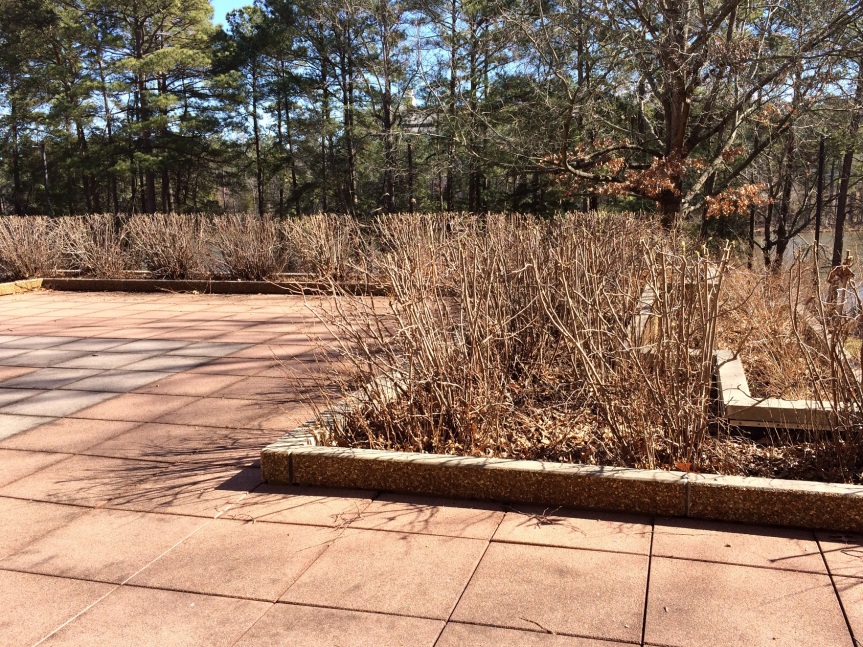
The landscapers groundskeepers at my workplace just finished pruning a hedge of witch alders, thus ruining their naturally elegant form and guaranteeing that they won’t bloom this year.
Witch alders (Fothergilla gardenii, Fothergilla major, Fothergilla ‘Mt. Airy’) are native shrubs that reward the gardener with licorice-scented flowers in spring, attractive foliage in summer, and bright color in autumn. Blooming is their first act after winter dormancy, so the flowers are borne on the stems that grew the previous year. By cutting the plants now, the groundskeepers have sheared off all of the flower buds that would have covered the plants with beautiful white flowers about two months from now.
Fothergilla also tend to branch after blooming, so the new growth emerging from these cuts will consist of straight stems with long internodes and few branches. By the end of summer, these plants will probably have put on as much height, if not more, than they would have if left unpruned. Where they have been cut at the same level several years in a row, they are starting to develop unsightly knobby growths that are wider than the stems below.
In situations where limiting height is a requirement, try planting the dwarf F. gardenii, not the much taller F. major or their hybrid ‘Mt. Airy’. And if you really must prune a witch alder, do it immediately after the the spring flowering. It is probably best to carefully remove individual branches to maintain the informal appearance of the bush instead of just cutting straight across the top. Really, apart from formal boxwood hedges, does anything look good when sheared square like the poor plants above?

Nick,
This from a retired landscaper (and fellow PBS member) – the malpruners of the Fothergilla weren’t really landscapers – or they would have pruned appropriately, if at all.
LikeLiked by 1 person
Fair enough. I edited that bit. No disparagement of good landscapers is intended. I don’t know what, if any, training and certifications these guys have, but they’re the people who mow the grass, mulch trees, plant annuals, and prune shrubs around the lab.
At least they don’t chop all the crepe myrtles.
LikeLike
Loved your struck-through “landscapers.”
“Landscalper” would be more accurate in many cases.
I’m hoping my condominium association’s board of directors can draft some decent specifications for our landscape. We have extremes: long-unpruned shrubs that are now trees, azaleas with much of the bloom wood sheared off, Leyland cypress planted within two feet of several buildings, eight-foot pyracantha “trained” on three-foot rail fences (not!). You get the picture.
LikeLiked by 1 person
I think the primary problem here was that they put shrubs with the potential to grow six feet tall at the edge of a patio where they’d block the desired view of the lake. Seems like the same planting style as at your condo.
LikeLike
We used to think that this was an isolated problem here in California, and maybe it was at one time. The industry used to attract those who flunked out of something else. I do not know what their excuse is now, since I know that many who do such horrible things actually know better, but are instructed to so by their ‘supervisors’, who probably flunked out of something else. Anyway, we eventually noticed this sort of . . . technique in other places like the Northwest and Tennessee. Nowadays, it seems that everyone all over the worlds has problems with it!
LikeLiked by 1 person
I think the root problem in this case was probably a builder planting what was cheap, even though it was ill-suited for the location. But the pruning definitely doesn’t help. If they really want views of the lake from that patio, someone should bite the bullet, grub out all the fothergillas, and replace them with something suitable.
LikeLiked by 1 person
‘Gardeners’ would be likely to plants something just as in inappropriate.
LikeLiked by 1 person
We are in the middle of the crape murder season here in Houston when countless innocent crape myrtle bushes are ruthless pruned back to a few sticks. By local Texas standards, those landscaplers did a half-hearted job.
LikeLiked by 1 person
Maybe you can leave an anonymous note explaining why this should not be done, with some references. I know a grounds-keeper that does this sort of thing. He will not listen to me. Now, he thinks the notes may be from a man or his boss. Ha.
LikeLiked by 1 person
No chance he reads a gardening blog like yours. He’s too busy planting things still in their pots. OMg! Truly I tell you.
LikeLiked by 1 person